There’s a quiet leak in many transport businesses that rarely makes it into boardroom slides. The slow, cumulative tax imposed by disconnected data and ad hoc processes, also known as digital drag. It isn’t a single catastrophic outage or an obvious outage, but a thousand tiny frictions. For example, a manager reconciling spreadsheets at midnight, or a pricing decision made on gut feeling. Over months and years, those little costs accumulate, eroding margins, tiring staff, and blurring strategic clarity.
Modern Bus Ticketing Systems aim to remove this invisible friction. They wire operations together so energy goes into growth instead of troubleshooting. The solution is Bus Management Software that closes gaps, provides operators with clear revenue signals, and prevents guesswork from becoming the norm.
If you’re curious about where your profit quietly slips away, read on. Looking at the full picture, you may find the problems are familiar, and the fixes are straightforward.
Explore how an Online Bus Booking System can streamline these gaps.
Yield Optimization Techniques for Bus Ticketing Systems
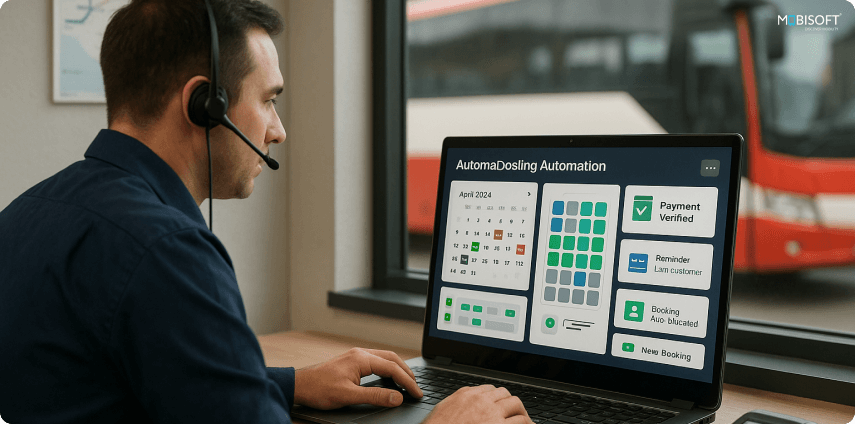
The Fixed-Price Trap: Leaving Money on the Table
Many operators price like the old days, seating plans based on routes and a handful of rules. That’s comfortable, predictable, and sadly expensive. When demand peaks or dips, fixed fares ignore nuance. Seats that could command higher fares stay pegged low, while low-demand trips still run full-service pricing that scares away occasional riders. Over time, that mismatch drains revenue potential. You end up with wasted upside on high-demand windows, and lost volume where a modest price nudge would have filled seats. This is less about complex math and more about missed signals.
Dynamic Pricing Engine as Revenue Lever
Introduce a dynamic pricing engine, and pricing stops being a calendar task and becomes an active revenue lever. Revenue management systems use fare analytics and demand-based pricing to adjust offers in near real time. They factor in booking velocity, historical demand, seasonality, even local events, and then recommend fares that maximize yield. The system nudges prices where appropriate, runs targeted discounts when fill rates fall, and avoids panic price cuts that destroy long-term fare memory. Importantly, these systems are permissioned. You keep guardrails, override where needed, and watch the optimization learn.
From Guesswork to Data-Driven Profitability
The leap isn’t futuristic, but procedural. Replace hunches with fare analytics dashboards, integrate booking data with route-level demand models, and measure incremental revenue per price point. A smart engine gives visibility into elasticity, showing where higher fares stick and where small discounts unlock volume. You begin to see pricing as a continuous process, not an annual chore. That frees commercial teams to test offers, refine segmentation, and run campaigns that increase average ticket value without alienating loyal customers. Naturally, there will be awkward lessons, some failed experiments, and a few course corrections.
Learn more about choosing the right system with How to Choose Bus Booking Software.
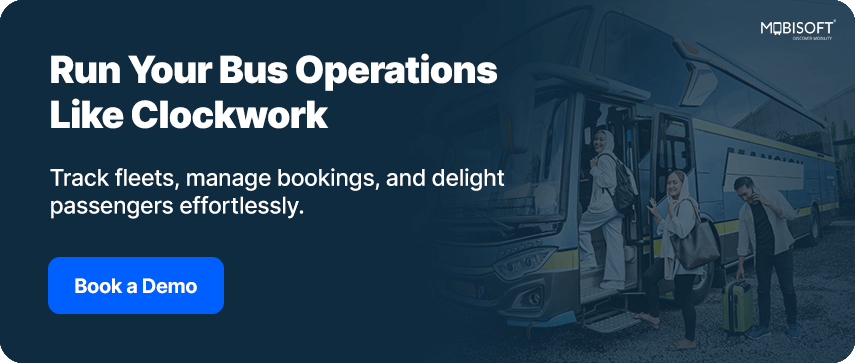
Real-Time Operational Dashboard for Transport Operators
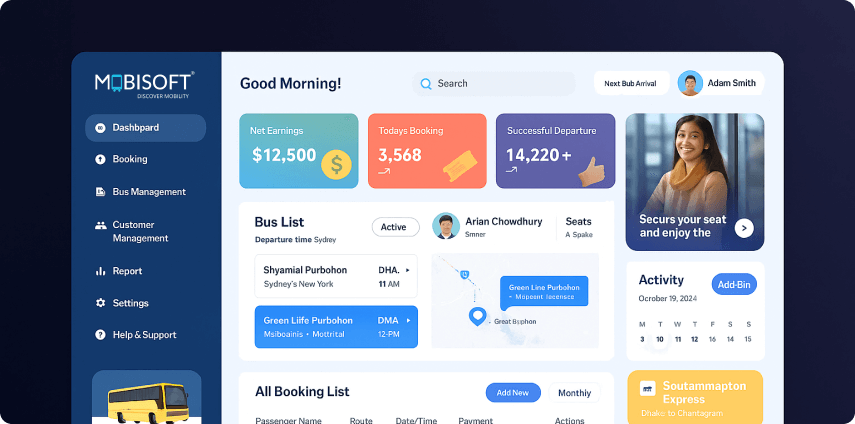
Cost of Operational Data Silos in Transit
It often starts with good intentions. A booking system added here, a fleet tracker there, a customer app built in a rush. Individually, they work, but together they speak different languages. Dispatch can’t see what sales sees, maintenance schedules live in someone’s inbox, and finance receives half-formed data once a week. This isn’t chaos in the cinematic sense, but it quietly burns time and patience. Teams end up solving data puzzles instead of serving passengers. The cost is subtle but relentless: delayed responses, duplication of effort, and avoidable operational errors. Many of these issues stem from the absence of unified systems, such as Bus fleet management software that brings everything under one workflow.
Integrated Fleet Management Platform Benefits
Integrated fleet management platforms and real-time operational dashboards offer a way out. They pull data streams from bookings, GPS, and service logs into one clean interface. The result isn’t more data, but better visibility. Managers can track utilization, monitor on-road performance, and spot service gaps without calling five people. A centralized Bus Ticket Booking System means fewer double entries and fewer human errors that come from juggling tabs. Over time, teams start trusting the data again, which may sound small but changes how decisions get made.
Dashboards for Performance Control
When everything runs from a single source of truth, response times shrink and accountability grows. Operations, finance, and customer service align because they finally reference the same metrics. It becomes easier to run proactive maintenance, rebalance fleets, and communicate changes before they escalate into issues. The goal isn’t micromanagement; it’s orchestration. A connected command center gives leaders freedom to focus on strategy, knowing that the daily rhythm runs on accurate, real-time information. Efficiency doesn’t come from working harder, but from removing the friction of working apart.
See how a Bus Transport Management System enhances visibility and coordination.
Mobile Booking Adoption and Passenger Communication Platforms
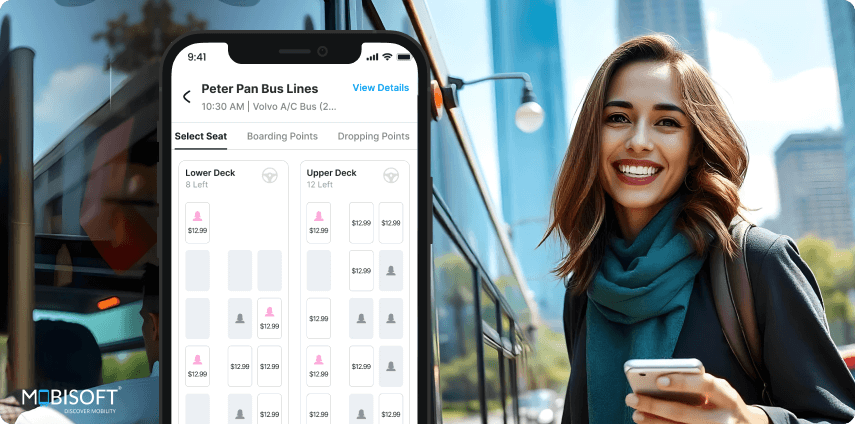
How Ticket-Only Systems Undermine Customer Loyalty
- A ticketing system that stops at payment is a lost opportunity. Passengers expect clarity, consistency, and reassurance in each booking.
- Missed update, a confusing app interface, and a call center that repeats scripted answers are communication pitfalls passengers remember.
- Retention in transport is tricky, but it begins with trust. A purely transactional setup builds none of it.
Omnichannel Passenger Journey via Contactless Ticketing
- Modern Bus Ticketing Systems extend beyond sales. They blend mobile booking adoption, contactless ticketing, and passenger communication into one continuous experience.
- A passenger can buy through an app, receive instant updates about schedule changes, and even rate their trip within the same system.
- These touchpoints turn routine commutes into predictable, low-stress experiences.
- For operators, every click and message adds to the data pool, feeding insights about preferences, timing, and loyalty triggers.
Building Brand Advocates, Not Just One-Time Riders
- The difference between a repeat rider and an advocate lies in emotional memory. When passengers feel seen and informed, they recommend.
- A system that automates timely alerts, offers loyalty perks, and remembers past journeys connects with users.
- Over time, it becomes an insulation against competitors who compete only on price. The journey no longer ends at the ticket gate; it continues in every communication that affirms reliability and care.
- Small gestures, like a personalized thank-you message or a seamless refund, often speak louder than any ad campaign.
Discover how a Bus Ticket Booking Mobile App System for Transportation Business supports end-to-end passenger communication.
Intelligent Decision Making through AI
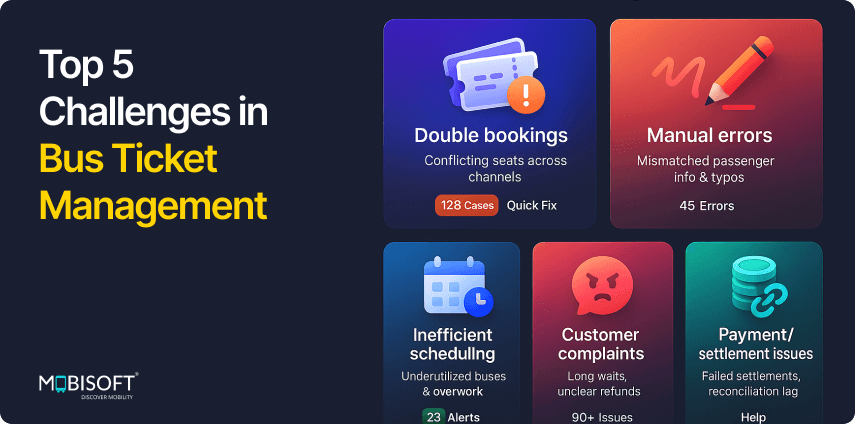
Data-Rich But Insight-Poor: The Analytics Gap
- Transport businesses rarely suffer from a lack of data, especially those using Bus Ticket Management Software. They suffer from too much of it, scattered across reports that say plenty but mean little.
- Each department tracks its own KPIs, yet no one connects the dots. Managers find themselves buried in charts, trying to interpret patterns that never quite align.
- So, while data feels abundant, actionable insight remains scarce. The irony is that numbers were supposed to simplify decisions, not complicate them.
Your AI-Powered Co-Pilot for Strategy
- With predictive analytics in transit and modern KPI dashboards, raw data finally finds its voice.
- AI-powered business intelligence tools digest route history, demand cycles, and cost behavior to suggest what comes next.
- They highlight profitable routes, identify underperforming services, and even anticipate maintenance needs before they become costly breakdowns.
- The dashboard becomes more than a display. It is like a quiet advisor, whispering where the next opportunity lies, a clear example of bus booking software benefits.
Moving from Reactive Reporting to Predictive Route Planning
- Once insights become forward-looking, management stops chasing problems and starts planning growth using data from Bus Ticket Booking Systems.
- Teams can test “what if” scenarios, explore fuel optimization, and fine-tune fleet deployment.
- The data loop closes as actions feed insights, insights refine strategy. Over time, leaders start trusting numbers again.
- They’re not perfect, but they finally tell a coherent story. And so, data stops being an archive and starts being a compass that guides how to manage bus bookings efficiently.
For fleet-specific insights, explore our Bus Booking System for Fleet Operators.
API-First Architecture for Scalable Fleet Management Software
Growth feels exciting until systems resist it. Many operators discover that adding routes, vehicles, or regions breaks old software logic. Legacy systems, built for smaller operations, can’t flex to handle modern complexity. They require manual workarounds, custom patches, or endless support tickets. The cost goes beyond money. It slowly eats away at momentum and makes progress feel heavier than it should.
Scalable fleet management software built on cloud-based transit solutions eliminates that ceiling. APIs let businesses integrate new tools, partners, Bus Fleet Management Software, or payment systems without reengineering the core. Expansion becomes a matter of configuration, not coding. Teams can launch pilot services, test new cities, or introduce tiered offerings without bringing operations to a halt. The more flexible the software, the faster innovation becomes routine. Growth should stretch your imagination, not your infrastructure.
Learn how automation strengthens scalability with an Automated Bus Ticketing System.
A Critical Warning: The Hidden Cost of Customization and Vendor Lock-In
When Flexibility Turns Costly
38% of IT organisations cite vendor lock-in as a top vendor-management challenge. New software demos always sparkle. But beneath the promises, some platforms quietly trap businesses in a new kind of dependency. The dashboards are tuned to your needs, and workflows are built to match. But soon, those tweaks make every update depend on the vendor, even when using Bus Ticket Management Software or similar tools.
Preventing Vendor Lock-In
To avoid that trap, prioritize API-first platforms and modular software architectures. Ask vendors not only what their systems can do, but how easily they connect to accounting, CRM, or marketing tools you already use. A good system should welcome external connections, not guard them. Flexibility should outlive the sales pitch, something crucial for any Bus Management Software.
Long-Term Software Scalability
This perspective reframes the buyer as a strategist, not just a shopper. Selecting an open integration platform means you’re building freedom into your tech stack. It ensures that if the partnership ever stops serving you, leaving won’t feel like starting over. True modernization gives you choice, not new chains with shinier links.
Path to Operational Excellence and Scalable Growth
Digital Drag isn’t loud, but it’s costly. The slow leaks of manual coordination, disjointed data, and inflexible systems can quietly drain both profit and morale even when operators use Bus Ticket Booking Systems. Replacing legacy setups with a connected, data-driven platform to modernize operations is necessary. It restores clarity, agility, and financial control.
The smartest investment isn’t only in new software, but in freedom: freedom from silos, from guesswork, from vendor dependency. The right platform becomes a strategic partner that powers smarter pricing, delighted passengers, and data-backed decisions. Take a closer look at your current system’s true cost of ownership. The hidden expense of Digital Drag might already be eating into tomorrow’s growth.
Dive deeper into the industry landscape with our Bus Transportation & Logistics Services overview.
Key Takeaways
- Dynamic pricing adjusts fares and shows teams how demand actually behaves, one of the core bus booking software benefits.
- When pricing adapts to real-time analytics, revenue becomes predictable and strategically earned.
- Integrated platforms prevent operational silos. Centralized visibility reduces friction, cuts down redundant communication, and stabilizes workflows that legacy tools often complicate.
- Passenger experience is now a measurable KPI. Every automated update, processed refund, or timely response builds customer confidence that no marketing spend can replicate.
- Data delivers value only when it informs decisions. Predictive intelligence converts scattered inputs into patterns that leaders can act on ahead of time.
- Scalability today means expanding networks without operational strain. Cloud-based, modular infrastructure enables seamless, cost-efficient growth.

FAQs
How does dynamic pricing actually help boost revenue for transport operators?
Dynamic pricing reads demand like a living signal and lets fares respond rather than sit frozen on a calendar. Seats sit empty when demand spikes, and that leaves money on the table. A well-tuned engine tests price elasticity, nudges fares up when riders will pay, and nudges them down to fill marginal seats, functionality often built into modern Bus Ticketing Systems.
Why is data integration more valuable than adding more point solutions?
Adding more tools often multiplies confusion instead of solving it. Teams spend hours reconciling spreadsheets, hunting for the source of truth, and retyping numbers into reports. A single integrated feed means bookings, GPS, maintenance, and finance all report the same facts, something Bus Ticket Management Software tries to streamline.
How does ticketing software elevate the passenger journey beyond the sale?
A passenger expects their trip to feel effortless from booking to arrival. Quick booking, clear updates, easy refunds, and instant support add up to a reliable experience that people remember. Small conveniences matter, like remembering travel preferences or offering timely compensation. Those moments build trust, and Bus Reservation Software plays a role here.
What makes legacy systems a hidden threat to scalability?
Old platforms tolerate current operations until you try to grow. Adding routes or opening new regions suddenly requires manual workarounds, and those hacks become permanent chores. That wastes time and invites errors. Cloud-based, API-friendly systems let teams configure new services instead of creating bespoke code essential for modern Bus Fleet Management Software.
Why do companies collect abundant data but still lack useful insight?
Storing data and understanding it are different tasks. Data scattered across tools reads like static, not direction. Analysts spend time stitching reports rather than spotting signals. Modern analytics unifies those threads and surfaces trends that matter to operators, such as route-level profitability or daily booking velocity, which are the key gaps even in advanced Bus Ticket Booking Systems.
How can operators avoid vendor lock when adopting new platforms?
Vendor dependency creeps in through bespoke integrations and closed upgrades. The best defense is insisting on open APIs and modular components up front. That lets you plug in accounting, CRM, or marketing tech without heavy migration work later. It also leaves room to swap vendors if performance or pricing no longer fits the needs for any Bus Management Software.
What does predictive management look like for everyday fleet operations?
Predictive management spots trouble before it becomes visible. Systems monitor usage patterns, maintenance logs, and driver behavior, then flag probable failures or capacity shortfalls early. Teams schedule repairs during low-demand windows and rebalance vehicles proactively. The daily result is fewer surprise breakdowns, steadier service, and a learning loop where operations improve, very useful for operators using Bus Fleet Management Software.
How does digital drag quietly erode profitability in transport businesses?
Digital drag accumulates from many small inefficiencies: duplicated entries, delayed reporting, and decisions made on incomplete information. Each incident alone seems tolerable, but together they slow down response and inflate costs. Automation and unified workflows seal those leaks, freeing staff from repetitive fixes, especially when implemented within modern Bus Ticket Management Software.

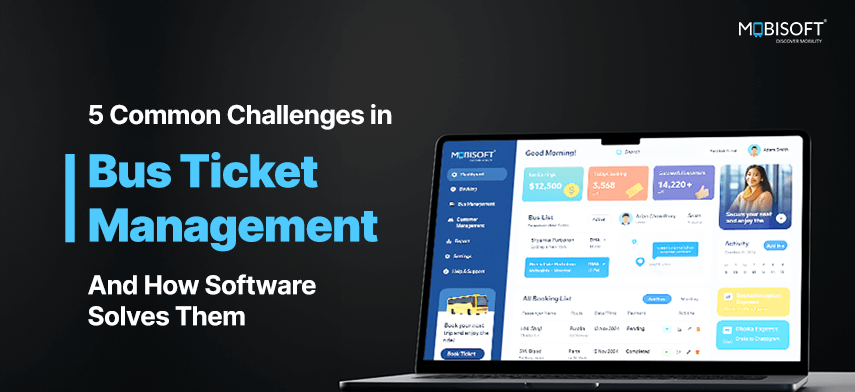


 October 17, 2025
October 17, 2025


